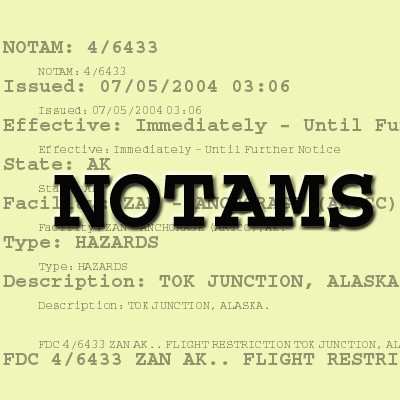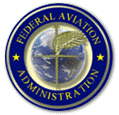Study Says Pilots Want Plain Language
Eighty-three people died in 2000 when an airplane crashed into
concrete barriers and construction equipment on a Taiwan runway.
Investigators concluded that the pilots had trouble extracting and
remembering information about the runway closure included in a
notice they had received before taking off.

To help prevent such crashes in the future, and to make flying
more efficient for pilots and passengers, University of Central
Florida researchers have suggested improvements to how notices
about runway closures, beacon outages and other temporary,
flight-related issues are presented to pilots.
Notices to Airmen, or NOTAMs, which pilots or airline
dispatchers check before every flight, are written in capital
letters with abbreviations that often are confusing. Pilots also
need to figure out which notices contain important information for
their flights and which ones include restrictions at airports
they're not using and at altitudes at which they're not flying.
UCF researchers, led by Team Performance Laboratory Director
Florian Jentsch, concluded that the notices should be written in
"plain and simple" language instead of abbreviations that can
confuse even experienced pilots. They also said the notices should
be better organized so pilots can sort the data and easily find
important information pertaining to their flights.
"This is critical information, yet the way it's transmitted is
vintage 1960s or 1970s at best," said Jentsch, who holds commercial
pilot and flight instructor licenses. "As a result, it's an
extremely confusing system, and it's very difficult to find what
you need."
Jentsch presented the findings in June at a meeting in
Washington, D.C., with officials from the Federal Aviation
Administration, the Aircraft Owners and Pilots Association, and the
Air Transport Association, a trade organization for US
airlines.
The research by Jentsch and graduate students Raegan Hoeft and
Janeen Kochan also has been presented at several other conferences
attended by leaders of the FAA; the International Civil Aviation
Organization, which strives to achieve international standards for
flight operations and safety; and EuroControl, an organization with
members from 33 countries that works toward a seamless air-travel
system in Europe. Flight Safety Digest, the leading publication of
the Flight Safety Foundation, published the findings this
spring.
 Kochan has worked 17 years as a
full-time pilot for cargo airline ABX Inc. She also has given
nearly 3,000 hours of flight training for pilots and is president
of a small business that offers training in human performance
skills and exercise physiology to the medical and aviation
industries and educational institutions.
Kochan has worked 17 years as a
full-time pilot for cargo airline ABX Inc. She also has given
nearly 3,000 hours of flight training for pilots and is president
of a small business that offers training in human performance
skills and exercise physiology to the medical and aviation
industries and educational institutions.
For more than a decade, pilots, air traffic controllers and
others have sought changes in the way Notices to Airmen are
delivered. Some changes have been made as technology develops, as
pilots now are able to access the notices online or by calling a
flight service center. The format of the notices, however, is
basically the same as when the messages were sent by Teletype
machines 30 years ago. Messages contain many abbreviations, and
there's no way for pilots to sort them by time, place or altitude
to figure out which ones are relevant to their flights.
Jentsch, Hoeft and Kochan gave written surveys to 77 pilots and
dispatchers, most of whom indicated they want the notices to be
written in "easy-to-read, plain language."
Jentsch said he is encouraged by the fact that the FAA,
International Civil Aviation Organization and EuroControl all seem
interested in working to change the way notices are issued and
received.
Changes would make flying safer and more efficient for pilots
and passengers, as pilots wouldn't have to spend as much time going
through the notices. The changes also could help pilots of private
planes stay out of legal trouble if descriptions of temporary
air-space restrictions, such as those that surround the president
wherever he goes, became clearer and easier to find, Jentsch
said.
UCF's Team Performance Laboratory has received $2.2 million from
the FAA in the last six years to help create scripts for
flight-training simulations and to study ways to improve training
for pilots in areas such as flying automated aircraft and dealing
with unexpected events. The Notices to Airmen portion of that
research cost about $75,000.
 ANN's Daily Aero-Linx (05.06.25)
ANN's Daily Aero-Linx (05.06.25) ANN's Daily Aero-Term (05.06.25): Ultrahigh Frequency (UHF)
ANN's Daily Aero-Term (05.06.25): Ultrahigh Frequency (UHF) ANN FAQ: Q&A 101
ANN FAQ: Q&A 101 Classic Aero-TV: Virtual Reality Painting--PPG Leverages Technology for Training
Classic Aero-TV: Virtual Reality Painting--PPG Leverages Technology for Training Airborne 05.02.25: Joby Crewed Milestone, Diamond Club, Canadian Pilot Insurance
Airborne 05.02.25: Joby Crewed Milestone, Diamond Club, Canadian Pilot Insurance




